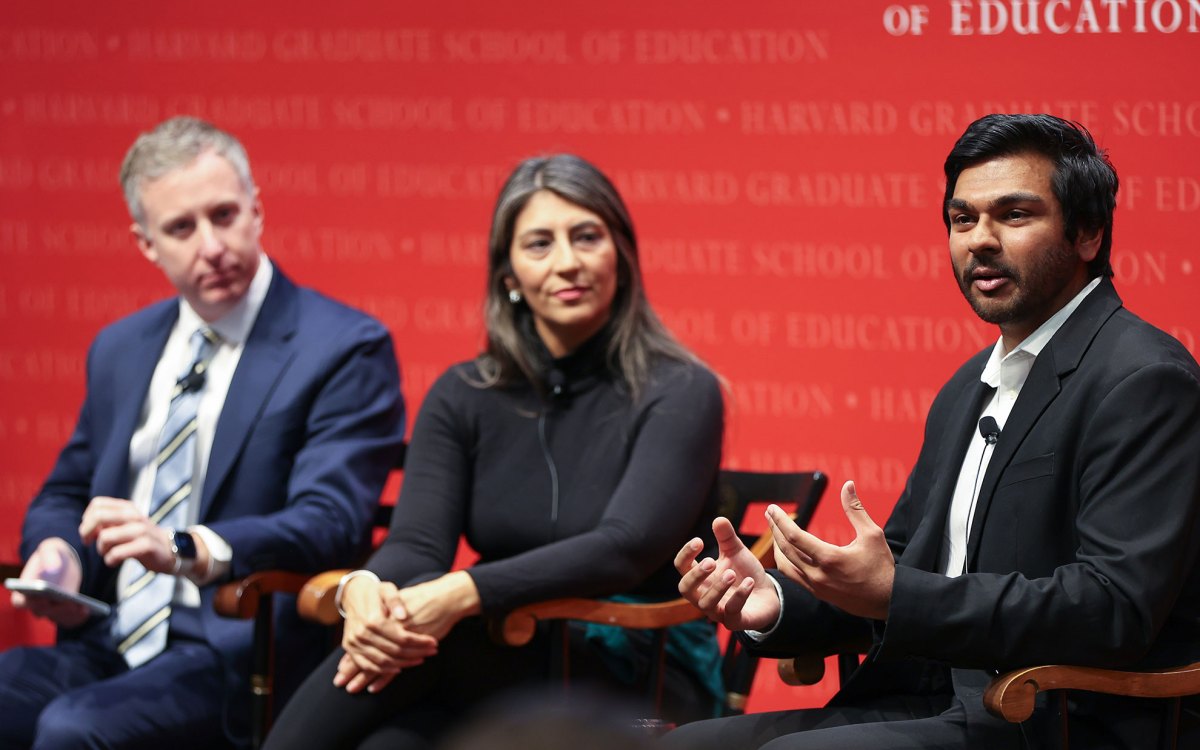
How progress happens
Vice provost for research details crucial role of NIH support in science and medicine
On Feb. 7, the National Institutes of Health issued a notice, effective Feb. 10, to cap reimbursements for indirect costs (IDC) associated with its grants. The world’s largest public funder of biomedical research, the NIH supports investigations into, among other things, efforts to fight cancer, control infectious disease, understand neurodegenerative disorders, and improve mental health. The agency is a significant sponsor of research at Harvard, with more than 1,500 active grants and $488 million in funding this past year; the new cap would result in a loss of more than $100 million annually for the University.
The move prompted multiple lawsuits to halt implementation of the change: one brought by the attorneys general of 22 states, including Massachusetts; one led by the American Association of Medical Colleges (AAMC); and a third led by the American Association of Universities (AAU), to which Harvard submitted a declaration of support. On Monday, a federal judge granted temporary restraining orders stopping NIH from taking steps to implement or enforce the change pending further orders from the court.
The Gazette discussed indirect costs with John H. Shaw, Harvard’s vice provost for research, who has kept the University community informed on recent changes and filed a declaration outlining Harvard’s position in the AAU case. This interview has been edited for clarity and length.

What are indirect versus direct costs?
Direct costs are costs related to the conduct of the work itself: in some cases, including salaries for those engaged in the project, equipment, travel expenses, and things of that nature. But when you think about the true cost of that work, other things also need to be considered: the building, the infrastructure, the labs that our researchers work in, electricity and utilities that support the building, and administrative staff that enables that research and ensures we are compliant with the terms and conditions associated with that research activity.
It is important to emphasize that all of those indirect activities are necessary to support the research activities. Reimbursements for indirect costs from sponsors such as the NIH don’t go into a slush fund for an institution to use as it sees fit. We have an obligation to the sponsor to ensure that those monies are spent to support the research.
So, though these costs are indirect, it’s not accurate to think of them as “incidental”?
No — they’re integral to the research. We need buildings; we need labs; we need computer resources; we need the networks to enable scholarship across so many fields and disciplines. Without the resources provided through reimbursement of indirect costs, the work essentially can’t proceed.
Over the last 20 years, there have been huge changes in how biomedical science is conducted. Have those changes affected indirect costs?
The innovation coming out of our labs is directly related to advances in technology over the last several decades. Consequently, the cost of research has increased across the board. For example, labs have become more sophisticated and imaging technologies have become more advanced. Equipment — much of it field-specific and highly specialized — has become more complex. And the costs of building and maintaining those lab facilities and specialized equipment, of providing the computers that power rigorous and novel analyses, have also increased.
Our strategy is to provide the resources needed for a particular lab through a sponsored research agreement or a University contribution. When something is needed by more than one investigator, we scale that resource and support it in a way that enables its use across the institution. This is the benefit of conducting research at a university level.
What is Harvard’s indirect cost rate?
The indirect rate varies somewhat across our Schools, but for the general University, the rate is 69 percent. That rate, considered in the context of other modifiers — such as subtracting elements like equipment expenses — determines the indirect costs that are reimbursed by the sponsor to support the research.
People often quote the 69 percent number. One point of clarification: This does not mean that 69 percent of the total funding goes toward indirect costs. It means that 69 percent of modified direct funding gets added on top to help defray some of the support costs. In the end, if you look at this all holistically, about 30 percent of the money we receive from the federal government for sponsored research goes toward indirect costs. The remaining 70 percent is used directly for the research activity.
The indirect funds we receive from a sponsor never cover the full cost of all the infrastructure and activity that are necessary to support research. The research partnership, between a university and a research sponsor, means that both of us contribute.
“However you do the accounting, less money invested in research and scholarship means fewer people engaged in research. It means less innovation and fewer discoveries from academic research labs that benefit the American people.”
In the NIH’s announcement, they cited lower numbers for other institutions. Why is Harvard’s rate higher?
Indirect rates across various sponsors, particularly between the federal government and foundations, are not directly comparable. They include and exclude different components to which the rate is applied.
Our indirect calculation is negotiated periodically between Harvard and the federal government. We calculate ours with the Department of Health and Human Services because of the degree of life science research in which we engage. The indirect rate calculation includes two components: an administration component and a facilities component.
The administration component encompasses, basically, the staff and systems needed to manage the project financially and ensure compliance with federal regulations and requirements. There’s a view that rising costs are due to administrative bloat — that the number of administrators is driving this up. But that’s not the case. The rate we receive for administration has been capped for more than two decades, and we spend more than we receive on indirect costs to ensure that these projects are properly supported.
The facilities component looks at our buildings, our labs, and the cost of maintaining and operating them, and that’s where variation between institutions happens. The portion of those facilities that is used for research is factored into this rate. That’s why different institutions in different parts of the country, with different real estate markets and scales and complexity of laboratory activities and other facilities, have different indirect rates.
You mentioned computing infrastructure as part of the growing expense of conducting research. Does the University provide computing resources centrally, or is it allocated to different grants?
Computing involves different components of support, some general and some research-specific. The general components tend to be covered within the IDC calculation. Those are items like the networks, basic data storage — things of that nature. Things that are project-specific — and often larger-scale — are typically included in direct charges. A good example is supercomputing resources. If you need access to a large GPU or CPU cluster to enable your science, there’s a rate you pay to whichever part of the University is supporting that cluster to give you access to that computer.
Another area where this is very important is in regulated data. These are data sets necessary for research that need to be kept private and secure, such as identifiable healthcare data. We have set up specialized systems and, over the last two years, have developed a University-regulated data environment that serves faculty across the institution. That’s an additional expense, dedicated to a specific type of research activity, and so faculty use would typically be included in the direct charges for a grant. So, there’s not one answer for computation. It really depends on the scale and the specific tie to the research activity.
So, since even just 10 years ago, we’re in a different environment with regard to dependence on big data, enormous computing power, and the associated costs?
Absolutely. I would add that we’re also facing an increasingly complex federal regulatory landscape. We need to ensure that the information and the findings supported by the federal government are secure. That means putting in place protections so that bad actors can’t access that data, which would not just undermine the contributions of our researchers, but also not be in the nation’s interests. So, this high-level computer capacity and the security systems that we put in place are both important national priorities — priorities that we share as an institution.
As vice provost for research, you filed a declaration in support of the AAU lawsuit. You estimated the cost of this change to Harvard as more than $100 million on an annualized basis for FY25, and $590 million through 2030. Can Harvard absorb these costs?
There would be pain associated with these changes. As a nonprofit, we reinvest our resources every year to advance our fundamental mission of teaching and research. To put these figures in context, the $100 million annualized cost is more than double the University’s operating surplus last year. So, despite having a significant endowment, we don’t have surplus resources readily available to meet that kind of shortfall.
Why can’t we use the endowment?
There’s a misconception that Harvard’s endowment can be used as a checking account. In reality, the endowment is made up of thousands of individual funds that are committed to specific purposes based on the legal terms of the donor’s gift. These philanthropic gifts are critical to supporting the University’s mission, including our commitment to student financial aid. Harvard distributes as much as it responsibly can from the endowment to serve current and future generations of students and scholars in advancing knowledge; to be clear, we do invest significant resources to support research beyond what we get from the IDC reimbursement. We strive to conduct all of this research at the highest level, and the investments we make signal our commitment to this goal. So, these changes would have a material impact on our ability to advance that research.
Another thing to recognize is that the NIH policy change does not mean that federal dollars will be redirected to support research in other ways — for example, through an increase in direct budgets. There will be less money invested in science. However you do the accounting, less money invested in research and scholarship means fewer people engaged in research. It means less innovation and fewer discoveries from academic research labs that benefit the American people.
What are recent examples of Harvard’s research benefitting the public?
There are many, such as gene therapies for disease — using novel gene-editing technologies as treatments for sickle cell anemia and other conditions. There are cellular and genetic therapies for treating certain types of cancer. There are investigations into understanding and mitigating the spread of infectious and drug-resistant disease. All those things have their foundation in academic research and would be impacted by this lower level of investment.
You mentioned in your filing a 75-year partnership between the federal government and research universities. How has this partnership worked?
It’s a partnership that is the envy of the world — one that’s driven scientific progress, economic growth, and American leadership in innovation and discovery.
The relationship is built around the recognition of the importance of fundamental research in driving scientific discovery. Fundamental research carries risk, because you often don’t know how it’s going to turn out and the path ahead is unclear. Academic institutions are well-suited to engage in true curiosity-driven discovery and innovation — more so than for-profit companies, which think on a shorter timeline and focus on how to develop research into things that will be profitable. This is the essence of the partnership: The government gets the most bang for its buck by partnering with institutions of higher learning and finding ways, as advances emerge, to translate them into positive economic and societal impacts in areas like healthcare.
You mentioned the economy. How significant are the economic benefits of research?
There’s a clear payoff, though its magnitude depends on who does the assessment. In Massachusetts, for example, every dollar of sponsored research invested by the federal government yields two to three times that benefit in its economic value to the region. It’s a win for both sides and serves as an economic engine for the state and the nation.
To take an example outside of the life sciences: Harvard is at the vanguard of quantum science, where there have been active scientific investigations for decades that were always viewed as fundamental and far from providing any benefit. But we’re now building quantum computers in the Massachusetts Green High Performance Computing Center. We have faculty members who are leaders in this space, who are developing new startup companies to ensure this transformation will have real, measurable economic impact across the state and the region. Federal funding has played a key role in quantum science research since its beginnings.
We’re rich with examples of fundamental research that takes time to percolate, whose ultimate impact is not known at the outset. That means it’s not a good idea to narrow your bets early on. Instead, you need to support broad scholarship and research and train the next generation of talent who, in some cases, are going to be the ones who take what you have learned and enable its impact.
How important is stability to the research? You make the point that research builds on what came before, and that disrupting research today slows things in the long run.
Disruption can hurt in a couple of different ways. For active research projects that involve cellular lines or animal research, you can’t simply stop without losing something significant. A pause means taking steps backward.
More importantly, though, this is about human beings. It’s about talent. It’s about the ability of people to learn and grow, to become more capable, to develop insight. In many ways, we are the world’s beacon for that process, that dream. People from across the world come to participate in that research mission. Turning off that pathway will have drastic long-term effects on the quality of the research that we engage in and, ultimately, on its impact on society.




